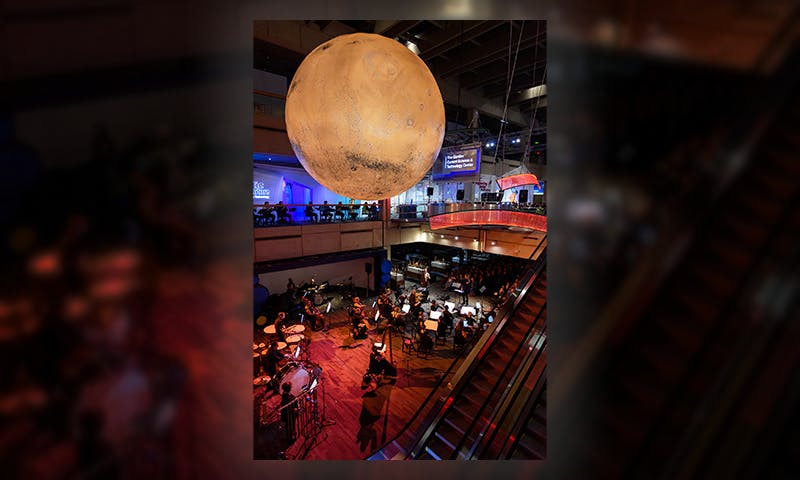The thundering of exploratory rockets, the eerie sounds of thin Martian winds, and the rumbles of seismic Marsquakes: These sounds gathered from the red planet will merge with orchestral music in Boston this month in the premiere of the Mars Symphony. The new composition aims to bring the thrill of space exploration down to Earth and turn the science of Mars into art.
The work by composer David Ibbett has its initial June 27 performance at the Charles Hayden Planetarium—part of Boston’s Museum of Science—which will be followed by two more, on July 25 and August 29, and later a national tour.
“I’m a trained classical composer, but my passion has always been for science,” says Ibbett. “There’s a sense of wonder that I think many musicians are now tapping into.”
It blends human creativity with our inherent instinct for exploration.
Mars Symphony combines samples of sounds from Mars itself, melodies created from probe data, and original visuals from the Charles Hayden Planetarium. The symphony consists of several movements that represent different aspects of Martian exploration.
“Sunrise Over Tharsis,” a musical interpretation of an imaginary flight at dawn over the Tharsis Mountains—Olympus, Arisa, and Alba Mons—incorporates data from an instrument on the Mars Global Surveyor called MOLA and melodies extrapolated from the mathematics of the curvature of the Martian mountains themselves. “Jezero Crater with Laurie Leshin” narrates the search for life by the Perseverance rover and includes the rover’s recordings of the Martian winds and seismic data from the InSight lander.
SUNRISE OVER THARSIS: Imagine flying over the Tharsis Mountains at dawn—Olympus, Arisa, and Alba Mons. The melodies in this movement are inspired by the curvature of the mountains, spanning from East to West.
Leshin, a planetary scientist and the director of NASA’s Jet Propulsion Laboratory in California, contributed voice clips for the narration to the composition. Like many of her lab’s projects, Mars Symphony brings the red planet “from imagination to reality,” she says in an email. “It blends human creativity with our inherent instinct for exploration.”
Another movement in Mars Symphony, called “Twin Worlds of Water,” incorporates audio of water from Earth to recall the ancient but now vanished seas on Mars; still another, “Otis Peak Sample Core,” is based on a “sonification” of a core sample from Jezero Crater that has been collected by the Perseverance rover for eventual return to Earth. The Otis Peak sample is the first taken from a “conglomerate” rock, which consists of sand, silt, clay, and pebbles. The movement uses strings, brass, and wind instruments to dramatize the way the different rock fragments were forced together by ancient waters on Mars.
MARCH TO MARS: A musical celebration of the heroic missions to Mars that may one day take us on a personal visit. Listen for the drum beats, built from samples from rockets recorded during the first SpaceX Starship launch.
The concert is part of the Multiverse Concert Series, which started a few years ago with performances at the planetarium of the Black Hole Symphony, a fusion of electronic and orchestral music with 3-D planetarium visuals. Each performance of the Multiverse Concert Series is informed by a science team from, among others, NASA and the Center for Astrophysics, which is run jointly by Harvard University and the Smithsonian Institution.
JEZERO CRATER WITH LAURIE LESHIN: Laurie Leshin, director of the NASA Jet Propulsion Lab, narrates this movement about the search for life by the Perseverance Rover and its core sample mission. In the background, we hear the real sounds of Martian winds and dust devils recorded by Perseverance’s microphones, as well as seismic data from the InSight lander.
In addition to Black Hole Symphony, Ibbett’s past works have included Cellular Dance—a 2019 ballet on the theme of cell movement—and Octave of Light, an album of his compositions based on exoplanet research and published in 2020. He is the first resident composer at the Center for Astrophysics, and a professor of music at the Worcester Polytechnic Institute.
OTIS PEAK SAMPLE CORE: A sonification of one of the most exciting core samples collected by Perseverance, which one day will return to Earth. Otis Peak is a fascinating mix of clasts—fragments of rock broken off by weathering—from different sources all over Jezero Crater, which have been compacted together by ancient waters. The strings play silver clasts, brass play black clasts, tam tam play grey, and winds play brown-colored clasts. We scan through the sample like the hands of a clock, clockwise, with higher pitches at the edges and lower at the center.
For aficionados, Ibbett’s Mars Symphony recalls The Planets, a famous orchestral suite by the English composer Gustav Holst that included a first movement called “Mars, the Bringer of War,” says Ibbett. Holst was inspired to write the piece in the early 20th century by the looming prospect of World War I. Echoes of Holst’s work make an appearance in the new Mars Symphony, says Ibbett, with a movement titled “March to Mars,” though the focus of the new symphony is really on the science of discovery.
He wants listeners to hear the thrilling story of planetary exploration in the music. “There is so much intricate and beautiful science and knowledge coming down to us,” says Ibbett, “and we can use music to highlight these natural wonders.”
Lead photo by Spencer Butterfield, SRB Photography
Tom Metcalfe
Posted on June 20, 2024
Tom Metcalfe is a science journalist based in London, where he writes mainly about space, energy, archaeology, Earth, and the oceans. He has written for Scientific American, National Geographic, Live Science, NBC News, BBC News, and others.
Get the Nautilus newsletter
Cutting-edge science, unraveled by the very brightest living thinkers.
>>> Read full article>>>
Copyright for syndicated content belongs to the linked Source : Nautilus – https://nautil.us/bringing-mars-to-earth-with-music-678056/
